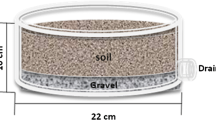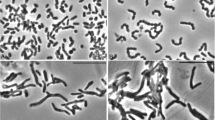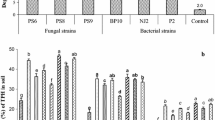Abstract
The potential of periwinkle shell (PS) in enhancing the microbial break down of crude oil spilled in soil were studied. The results revealed that the counts of crude oil degrading bacteria in oil-polluted soil fortified with PS were higher than the counts in unfortified soil. The rates and total extent of crude oil biodegradation in the soil were stimulated by the amendment. About 43.4 percent of crude oil was degraded in unfortified soil after 16 days as compared to 70.1 percent oil biodegradation, which occurred in PS fortified soil during the same period. These values were significantly (P>0.05) different from each other. Amendment of the soil with PS also raised the pH of the soil from acidic to alkaline range. The crude oil degrading microorganisms identified in PS amended soil were of the genus Pseudomonas, Bacillus, Micrococcus, Acinetobacter, Penicillium, Aspergillus, Mucor and Rhizopus. Similarly, Pseudomonas, Bacillus, Micrococcus, Mucor, Aspergillus and Penicillium were identified as crude oil degrading microorganisms in unamended soil. The bacteria formed either stable or unstable emulsions, suggesting that the organisms produce surface-active agents (biosurfactants) during the biodegradation process. The results of this study indicate that PS can be used in reclaiming oil-polluted soil.
Similar content being viewed by others
References
Alexopoulos, C.J. and Mims, C.W.: 1979, Introductory Mycology, 3rd edn., Wiley, New York, pp. 3–572.
Bossert, I. and Bartha, R.: 1984, 'The Fate of Petroleum in Soil Ecosystem,' in R.M. Atlas (ed.), Petroleum Microbiology, Macmillan Publishing Company, New York, pp. 435–473.
Cooper, D.G.: 1986, 'Biosurfactants,' Microbiological Science 3(5), 145–149.
Cowan, S.T.: 1974, Manual for the Identification of Medical Bacteria, 2nd edn., Cambridge University Press, Cambridge, pp. 56–82.
Dibble, J.T. and Bartha, R.: 1979, 'Effect of Environmental Parameters on the Biodegradation of Oil Sludge,' Applied and Environmental Microbiology 37, 729–739.
El-Nawaway, A.S., El-Bagouri, I.H., Abdul, M. and Khalafawi, M.S.: 1992, 'Biodegradation of Oily Sludge in Kuwait Soil,' World Journal of Microbiology and Biotechnology 8, 618–620.
Ijah, U.J.J.: 1998, 'Studies on Relative Capabilities of Bacterial and Yeast Isolates from Tropical Soil in Degrading Crude Oil,' Waste Management 18, 293–299.
Ijah, U.J.J. and Antai, S.P.: 2003, 'The Potential Use of Chicken-Drop Microorganisms for Oil Spill Remediation,' The Environmentalist 23, 89–95.
Ijah, U.J.J. and George, B.G.: 1998, 'Potentials of Yeast Isolates in Decontaminating Crude Oil Spilled Soil,' Nigerian Journal of Science and Technology 1(1), 189–195.
Ijah, U.J.J. and Kenneth, A.A.: 2002, 'The Role of Cow Dung and Inorganic Fertilizer in Microbial Degradation of Crude Oil in Soil,' a paper presented at the 15th Annual Conference of Biotechnology Society of Nigeria, 31st July- 3rd August 2002, Ambrose Alli University, Ekpoma, Nigeria.
Ijah, U.J.J and Safiyanu, H.: 2003, 'Comparative Study of Biodegradation of Escravos Light Crude Oil in Soil Amended with Chicken Droppings and NPK Fertilizer,' Journal of Applied Science and Environmental Management (in press).
Ijah, U.J.J. and Ukpe, L.I.: 1992, 'Biodegradation of Crude Oil by Bacillus Strains 28A and 61B Isolated from Oil Spilled Soil,' Waste Management 12(1), 55–60.
Kokub, O., Shafeeq, M., Kahlid, Z.M. and Malik, K.A.: 1989, 'Isolation, Screening and Characterization of Biosurfactant Producing Bacteria,' in K.A. Malik, S.H.M. Naqui and M.I.H. Aleem (eds.), Proceedings of International Symposium of Biotechnology for Energy, December 12- 16, NIAB/NIBGE, Faisalabad, Pakistan, pp. 221–232.
Leahy, J.C and Colwell, R.R.: 1990, 'Microbial Degradation of Hydrocarbons in the Environment,' Microbiology Review 54, 305–315.
Miller, R.W. and Donahue, R.L.: 1990, Soil: An Introduction to Oil and Plant Growth, 6th edn., Prentice Hall Limited, New Delhi, pp. 425–433.
Nuguru, D. and Edward, H.M. Jr.: 1983, 'Influence of Dietary Calcium and Phosphorus on the Magnesium Requirement of Chicks,' Journal of Nutrition 80, 181–184.
Pruthi, V. and Cameotra, S.S.: 1997, 'Production of a Biosurfactant Exhibiting Excellent Emulsification and Surface active Properties of Serratia marcescens,' World Journal of Microbiology and Biotechnology 13, 133–135.
Rocha, C., San-Blas, F., San-Blas, G. and Viernial, L.: 1992, 'Biosurfactant Production by Two Isolates of Pseudomonas aeruginosa,' World Journal of Microbiology and Biotechnology 8, 125–128.
Westlake, G.W.S., Jobson, A.M. and Cook, J.D.: 1978, 'Degradation of Oil in Soil in the Boreal Region of the North West Territories,' Canadian Journal of Microbiology 24, 254–260.
Zajic, E. and Supplisson, B.: 1972, 'Emulsification and Degradation of “Bunker C” Fuel Oil by Microorganisms,' Biotechnology and Bioengineering 14, 331–343.
Author information
Authors and Affiliations
Rights and permissions
About this article
Cite this article
Ijah, U., Ndana, M. Stimulated Biodegradation of Crude Oil in Soil Amended with Periwinkle Shells. The Environmentalist 23, 249–254 (2003). https://doi.org/10.1023/B:ENVR.0000017379.37520.f2
Issue Date:
DOI: https://doi.org/10.1023/B:ENVR.0000017379.37520.f2




